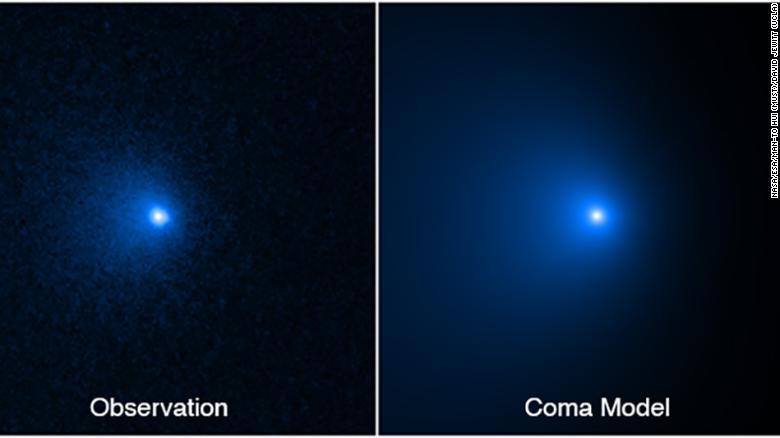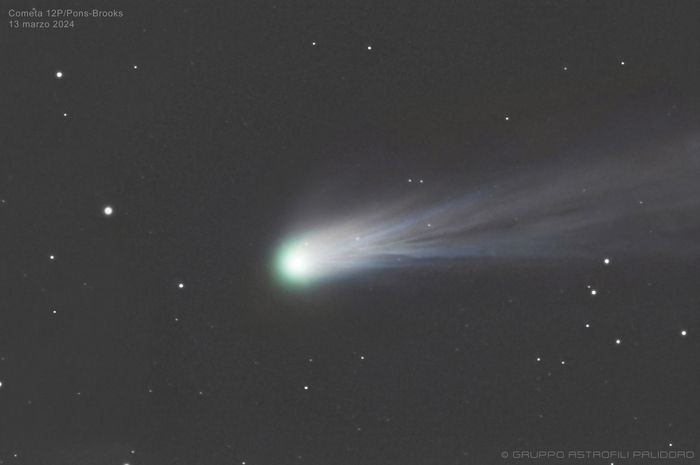They manage to determine the size of the largest comet 0:43
(CNN) --
A comet with a nucleus larger than the state of Rhode Island is headed our way, but Earth is in no danger of a "Don't Look Up" movie-like situation, astronomers say. .
Although comets are most recognizable by their tails, which can stretch for millions of miles, the heart of a comet is its solid nucleus.
This core is made of ice and dust, which forms a dirty snowball.
While most known comet nuclei measure a few kilometers across, astronomers using the Hubble Space Telescope discovered Comet C/2014 UN271 with a nucleus reaching 136.7 kilometers across.
That's more than twice the width of Rhode Island.
These images show how the nucleus of comet C/2014 UN271 (Bernardinelli-Bernstein) was isolated from its coma, a cloud of dust and gas that surrounds the solid icy part of the comet.
This nucleus is about 50 times larger than those of other comets, and has an estimated mass of 500 billion tons, which is 100,000 times larger than the mass of a typical comet.
The comet is traveling at more than 35,000 kilometers per hour from the edge of our solar system and will make its closest approach to us in 2031. But it will never come closer than one thousand six hundred million kilometers from the Sun, only a little more than the distance between Earth and Saturn.
The comet was discovered by astronomers Pedro Bernardinelli and Gary Bernstein while examining archival images taken by the Dark Energy Survey at the Cerro Tololo Inter-American Observatory in Chile.
The comet was first observed in 2010 and is also known as Comet Bernardinelli-Bernstein after the astronomers who discovered it.
Since then, astronomers have observed the comet with telescopes on the ground and in space.
advertising
This diagram compares the size of Comet Bernardinelli-Bernstein's solid, icy nucleus with that of other comets.
In January, researchers used the Hubble Space Telescope to take five photos of the comet.
The images are part of a new study published Tuesday in the academic journal The Astrophysical Journal Letters.
"This comet is literally the tip of the iceberg of many thousands of comets that are too faint to be seen in more distant parts of the solar system," said study co-author David Jewitt, a professor of planetary science and astronomy at the University of California. , Los Angeles, in a statement.
"We have always suspected that this comet had to be big because it is so bright at such a great distance. Now we confirm that it is."
Comets are relics from the early days of the solar system, icy pieces left over from the formation of the planets.
The gravity of the larger planets ejected the comets into the Oort Cloud, and the cloud is now home to distant comets at the edge of our solar system stretching out into deep space.
Comets return toward the sun as their orbits experience the gravitational pull of passing stars.
This comet has been traveling towards the Sun for millions of years 0:34
In a few million years, Comet Bernardinelli-Bernstein's orbit will return it to the Oort Cloud.
"This is an amazing object, given how active it is even when it's still so far from the Sun," said lead author Man-To Hui, an assistant professor at the Macau University of Science and Technology in Taipa, Macau, in a release.
"We assumed that the comet could be quite large, but we needed better data to confirm this."
The research team used the Hubble data to distinguish the comet nucleus from the coma or hairline, or the dusty envelope that surrounds a comet as it approaches the sun.
Heat from the sun warms the comet as it approaches, causing parts of it to sublime, or change from a solid to a gas.
This cloudy coma is the reason why comets appear blurry when we view them through telescopes.
The team's analysis not only revealed the size of the core, but also the fact that it is darker than coal, Jewitt said.
The comet experiences an oval orbit lasting 3 million years.
At the moment it is less than 3,000 million kilometers from our sun.
Astronomers hope that studying Comet Bernardinelli-Bernstein could reveal more about the Oort Cloud, which was first hypothesized by Dutch astronomer Jan Oort in 1950. The cloud remains a theory because it is too far away to be observed, so the largest structure in our solar system is essentially invisible.
NASA's Voyager spacecraft won't reach the interior of the Oort Cloud for another 300 years, and it could take 30,000 years to traverse it.
But each comet that approaches the Sun reveals more details about its mysterious home.
Hubble Space Comet Telescope






